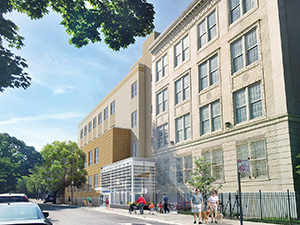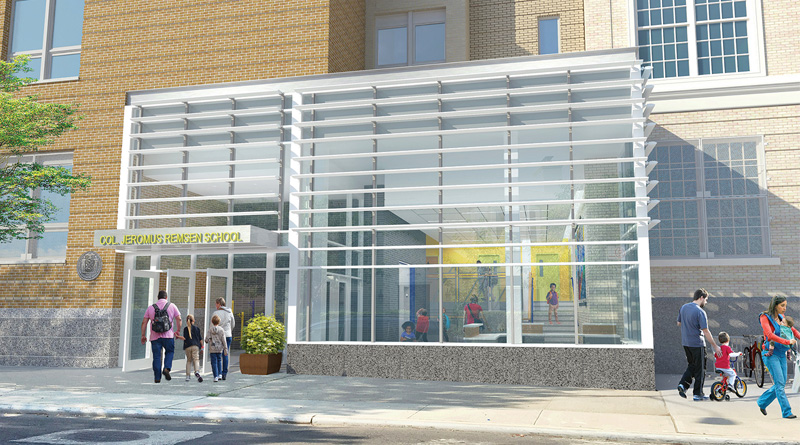Adding Up: NY Elementary School Breaks Ground on Ambitious Project
By Daedalus Howell
QUEENS, N.Y. — Sometimes schools teach algebra; sometimes their names sound like algebra. Such is the case for P.S. 144Q, otherwise known in Queens as Public School 144 Colonel Jeromus Remsen School, which is doing a little math of its own — namely addition.
A December groundbreaking ceremony marked the beginning of a large-scale addition to the elementary school to accommodate a student body expected to grow from 894 students to nearly 1,600 in the coming years.
The ambitious, $52.4 million, four-story addition will house 26 new classrooms, an entrance lobby, an outdoor play area, a cafeteria, offices and a medical suite. Designed in accordance with the NYC Green Schools Guide and Rating System by New York-based Urbahn Architects, the addition will put a premium on energy efficiency and a healthy environment, whilst preserving the original building’s early 20th century aesthetic.

Photo Credit (all): Urbahn Architects
“In addition to accommodating the school’s functional and programmatic needs, Urbahn’s architectural team has focused on ensuring that the design of the new building respects both the look of the existing school and the scale of the surrounding single-family home residential neighborhood,” said Urbahn Designer and Principal Martin D. Stein, AIA, in a statement.
Stein also added that the original building, which was erected in 1931, will be matched by incorporating a two-story brick portion into one of its facades in an effort to visually reduce the perceived scale of the addition. “It features a contrasting brick color to draw attention to the smaller scale of the lower portion,” he added.
Besides the new student and faculty spaces, the addition includes improvements to the current facility that will see the replacement of door knobs with ADA-compliant door latches, relocations and renovations to its bathrooms, an upgraded exercise room, a guidance suite, auditorium and four classrooms. An inclined chair lift will be installed to provide access to the lower area of the third floor of the existing structure. Likewise, the school will obtain ADA-compliant water fountains featuring bottle-filling stations.
Of note is the entrance lobby, which will be 16-feet high and boast a large glass-and-metal storefront, complemented by a broad stairwell that will lead down to the student dining room level. Don’t want to take the stairs? No worries, the ADA-compliant upgrades realized in the entrance and lobby will also benefit from the installation of two elevators.
“The new building will accommodate 590 students and address functional deficiencies of the existing school,” Stein said in a statement. “The expansion will also eliminate the need for the currently used temporary modular, outdoor classroom facilities. The project was designed to address the school’s needs in the most cost-effective manner and to minimize the extent of renovations to the existing building, which will continue to operate during construction.”
The cellar of the new building will house both a kitchen and a dining room, the latter of which will be treated with acoustic fixtures on the ceiling and walls that will dampen noise within the space. And to allay any sense of being underground, the cafeteria’s ceiling will be fitted with a simulated skylight that uses daylight-hued LED lighting fixtures. Moreover, the ceiling will be treated as floating islands to create visual divisions to help foster the sense of discrete locations within the otherwise open space.
An all-new principal’s office and general offices will be located on the first floor. The first and second floors will house Pre-K and kindergarten classes as well as a newly designed, dedicated ECC playground. The third and fourth floors will provide classrooms for second and fourth graders as well as several resource rooms.
To read the entire article, check out the January/February issue of School Construction News.

